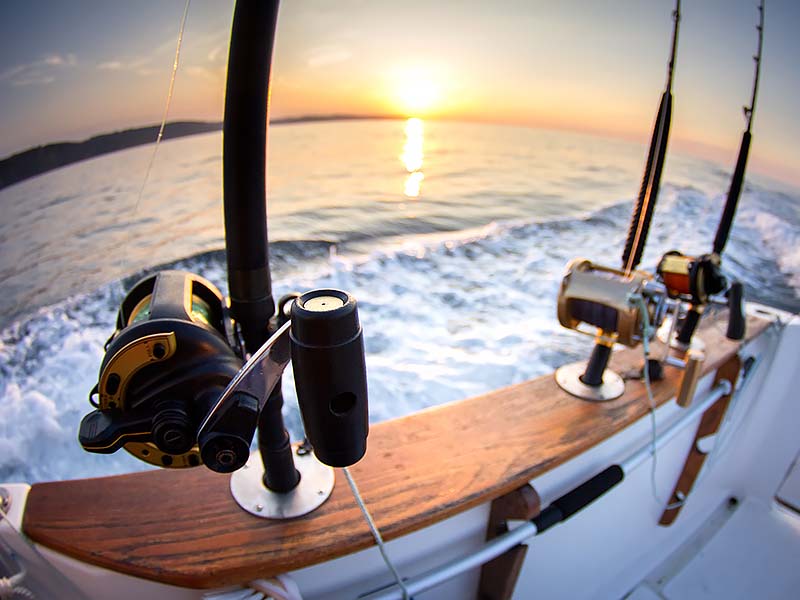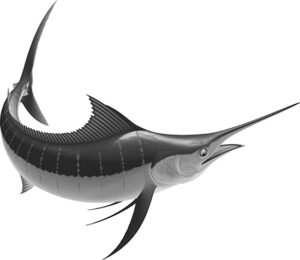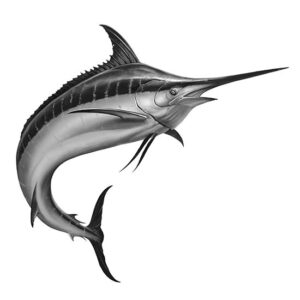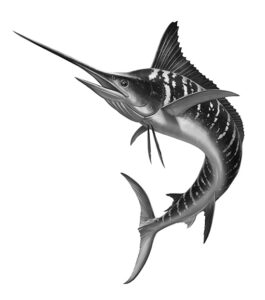
Blue Marlin is perhaps one of the most sought-after big game fish on the planet. The record for blue marlin in Florida is 1024 pounds. [1] Given both of these facts is the question, how do you catch a blue marlin in the Gulf? The simple answer is that you troll for these big trophy fish using big dead bait – whole or cut.
Some anglers may use live bait but when trolling it makes it much more difficult to attract and then hook the marlin. The reason dead bait – preferably whole – is that the dead fish will swim more naturally in the water as you troll, and that is how to catch a marlin in the Gulf. There is a bit more to it, but not much, and we go deeper with the details further inside.
Spotting The Four Marlin Species
There are four species of marlin in the Gulf – Black marlin, blue marlin, White marlin, and striped marlin. Here’s a little deeper information about all four.
Blue Marlin

- Best Bait – Whole blackfin tuna, skipjack, and bonito are three of the top dead fish baits for blue marlin. People are also successful on occasion with flashers that mimic any of these fish.
- Best Destinations – Destin Florida is the top destination for blue marlin. It is here where the record 1046-pound blue marlin was landed by a charter boat. Other locations include along the panhandle – Panama City, etc.
- What To Look For – Schools of flying fish, mackerel, and other balls of fish are often a good indication of marlin. Another clue to the presence of marlin is birds feeding in open water. Diving birds, such as seagulls and pelicans will feed on the baitfish that the marlin push to the surface.
Black Marlin

- Best Bait – Mackerel, Bonito, or If you can find them, squid. Whole fish in the foot plus range in size. Dead bait is one of the best options over live fish because it will trail in the trolling waters allowing the marlin an easy grab.
- Best Destinations – Two of the best destinations for Black marlin are off the coast of Santa Rosa Beach and Destin, Florida.
- What To Look For – Warm water is key. They like to hunt near shore and along shallow coral reef units. They will pick off smaller predatory fish – small tuna, mackerel, squid, as they forage.
Striped Marlin

- Best Bait – Live or dead – Mackerel, sardines, and big eye are three of the top baits.
- Best Destinations – Destin, Panama City, and along the panhandle.
- What To Look For – Look for water temperatures that range from 65F- 75F. Troll in long sweeps past structures, reefs, wrecks, and oil rigs.
White Marlin

- Best Bait – Smaller baitfish – anchovies, mackerel, herring – even bonefish will attract white marlin. Dead is good – live bait will work, so will bait fish mimics and spoons – The best bait is a small (foot size) mackerel.
- Best Destinations – Throughout the Gulf of Mexico, the Atlantic, and around Miami.
- What To Look For – Water temperatures above 66F and target them in the mid to top level of the water column. They will come inshore after baitfish or to hunt for squid.
How To Catch Marlin
The best way to catch blue marlin is by trolling with a dead bait trailing the boat. Keep the speed under five knots, making long sweeps through the clear water. A nice oily fish will often do the trick to attract a marlin, but you will need to calm down and let the fish, hook itself. Marlin will suck in your bait as it does, feeding the line off the spool so that the line catches the current and drags the hook into the jaw. If you yard the line to set the hook you will likely float the hook right out of the fish’s mouth.
Blue Marlin Fishing Techniques
- Pitch Bait – A sight fishing technique – Marlin are often curious, and you may spot a marlin near the boat either investigating the disturbance or tracking the bait you are tolling. If your rig is already in the water and fish is not near it, a pitch bait comes in handy. A pitch bait is a rod already rigged with a dead bait fish on the hook. You “Pitch” the bait toward the marlin in hopes it will take the hook.
- Trolling – The only way to really catch a marlin IMO is to troll. Marlin pick off smaller predatory fish, squid, and baitfish that they find in open water. Trolling a stretch of ocean with a few leaders out and trailing a 1–2-foot mackerel, or other appropriate bait, will bring the marlin in near the boat. Dead fish are best because as you troll at low speeds, the dead fish will simply swim in a side-to-side fashion rather than all over the place. Marlin will trail the boat, and then strike the fish and a dead fish that is swimming due to the current created by the trolling motion of the boat will be an easy target. Troll at five or fewer MPH so that the bait is beneath the surface and not bouncing along the top of the water.
- Harpoon – Sinking a harpoon into a big marlin is intense. It is not for the faint of heart. These fish have a ton of power, and they explode out of the water. Hooking one on a fishing rod is a better way to control the fish and tire it out.
Blue Marlin Fishing Tips
- Use Natural Bait – Natural bait is a live fish or dead fish. Dead is preferred, though there are many arguments over which type of natural bait is better. The reason we say use a dead fish is how the dead fish “swims” behind a trolling boat. If you get the trolling speed correct, the dead bait will wobble side to side and remain under the water’s surface. A live fish may become erratic making it more difficult for the marlin to take the bait.
- Artificial Baits – Artificial baits can work to catch marlin, but many anglers already feel that catching a blue marlin is difficult. Part of that struggle is bait choice. If you are going to use artificial baits, use the ones that resemble big bait fish. It is not uncommon to use a dead mackerel in the 1-2 foot length. Some marlin will go after sardine-size baits, others will chase larger prey. Big squid lures are one I would try. If you are not getting results with artificial lures, take the time to jig for smaller predatory fish, such as smaller blackfin tuna, mackerel, or bonito fish, and switch to natural bait.
- The Right Gear – 100-pound monofilament line is a standard line for marlin. You pair that with a good reel with a lever drag in the 80-class range. A rod that is 12-weight will do for smaller fish – those under 100 pounds, but larger marlin will need a 14 or 16-weight rod.
- Find Their Habitat – water temperature plays a big role in where you find blue marlin. Look for water temperatures above 70°F and below 85°F. That spot will change throughout the year and seasonally. Look also for schools of baitfish, though blue marlin will hunt single fish, especially smaller predator fish, like blackfin tuna. These fish will stick near structures until nighttime where they will swim off in search of stray baitfish or squid. That is when the Marlin will take them. Long sweeps trolling past structures can catch the eye of marlin, which are visual hunters. Off the coast of Destin and along the panhandle where the water is 70-85°F is ideal.
Gulf Coast Laws
- Minimum Size Limit – For blue marlin they have to be longer than 99 inches from their lower jaw to the tail fork. For white marlin, they have to be 66 inches or longer also measured from the jaw to the tail fork.
- Daily Bag Limit – Florida says one billfish per day regardless of species.
- Season – open year-round, but warmer months are best with August, September, and October being the best.
Frequently Asked Questions
- How Long Does It Take to Reel in a Marlin? Usually, it takes about 45 minutes to an hour to tire out a blue marlin. It can take longer for bigger fish.
- Where Can You Catch Marlin? Marlin are available around the world. They prefer tropical and subtropical waters and the Gulf of Mexico is a perfect destination, especially around the panhandle and off the coast of Destin, Panama City, and Santa Rosa Beach.
- What Do You Do with a Marlin After You Catch It? Most anglers release blue marlin after they catch it. That is to help conserve the species. Blue marlin can live for 20 or more years, and it takes a long time to replace a big marlin. Some people may choose to keep their catch, but in Florida, you are limited to one billfish, regardless of the species. You may choose to eat the fish or have it preserved for display.
